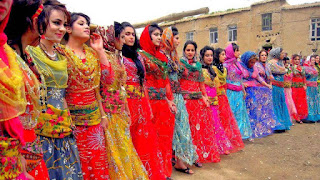We know the bible, we know the stories but how well do we know of the beginnings - the first of the first. Not many can say they have heard of Howraman- the kurdish territory in the north of Iran. Lend me your ear and hear this story as told by a local from Time Tunnel Travelling.
There is a saying among the Kurds- there are no friends BUT the mountains. To trace the history of the Kurds we will start at the very beginning. It was here, in the land some believe was once the Garden of Eden that this resilient ancient people first left their mark upon the world. Archeologists believe it was within this 'Cradle of Civilization' that the Kurdish ancestors first pioneered agriculture, animal husbandry, weaving, metal work and the making of pottery. For visitors a trip to the land of the Kurds is a trip to Biblical history. The great prophets Nahum, Jonah, Habakkuk and Daniel are all buried within the vast borders what came to be known as Kurdistan.
Caught at the intersection of powerful empires, the Kurds had their homes destroyed so regularly in medieval history that, by the XVIII century, a sizeable part of society had foregone villages altogether and resorted to nomadism and brigandry. An important exception, thanks to its impenetrable mountain-hemmed position, was the Howraman valley. This remains one of Iran's least known and most spectacular areas in Kurdistan of Iran.
History
The History of the Kurds dates back to 57,000 years ago, and even more, with evidence of stone age (Middle Paleolithic) people living in six caves near the village of Hazar Merd, south-west of Suleimaniah. In one cave near Zarzi village, many flint implements of the upper paleolithic era have been found.
The earliest archaeological evidence shows that the region was inhabited by humans since the middle paleolithic period. Evidence was discovered by archaeologists near Hajij village and includes stone tools made by Neanderthals or early modern humans. Evidence for late paleolithic occupation discovered in a cave site in the Perdi Mala valley.
Culture
Kurdish culture originates from their lives in the mountains. In colder months you will still see Howraman men wearing kolabal, brown-felt jackets with distinctive shoulder 'horns' that is made from the goat's hair. Howrami people also use local shoes that date back 1,500 years. The 'Chokho Ranak' that is made by goat's hair is also worn as clothing.
In Howraman District the locals sing the 'mother of all songs' with 7,000 years of history called 'Hora', another song 'Sya Chamana' has records showing 3740 years of history. This local song is taken from the voice of Quebec.
Kurdish people are called to be equal in their society through dance, a dance from prehistoric ages that has a different characteristic to other Middle Eastern dance. They do not segregate men and women so all people dance in the same line.
Village Structure
Old stone terracing in the villages is stacked Masuleh-style, one house's roof forming the next one's yard. An example of this kind of structure is Pawa (Paveh) city, the biggest stepping or terracing city in Iran.
The proximity of the houses to each other has a direct impact on the culture among the people of the village in such a way that the people of Howraman are known as the most hospitable people in Iran.
Society and women's rights
Woman in the Kurdish language are referredto as 'Afrat' meaning 'creator'. It is not an exaggeration to say that women of Kurdistan are the lords of this land. In the heart of Howraman district the village called 'Dawan' is known through history as published by Iranian national media to be 3,500 years old but the locals believe that Dawan village has a 5,500 years history. Here women were scholars who attended schools and universities.
***Credit and information for this article courtesy of Mr Salman Enferadi and Mr.Farzad Ravand



No comments:
Post a Comment